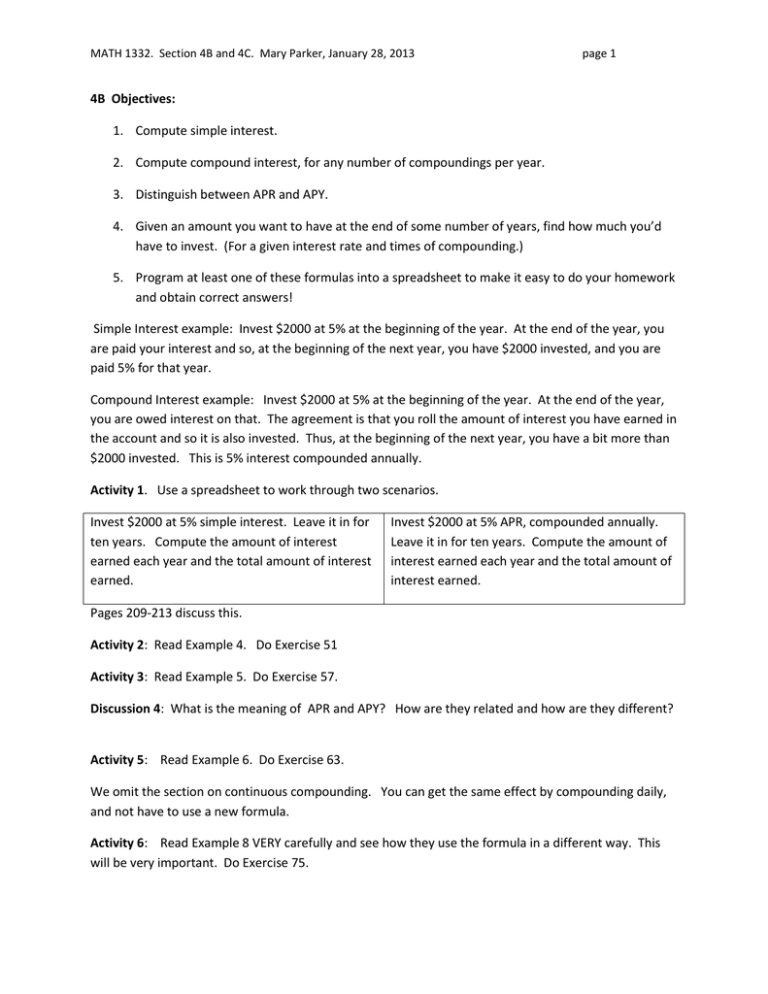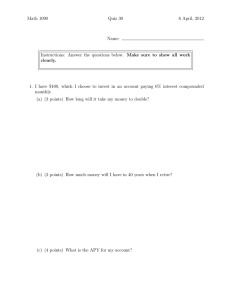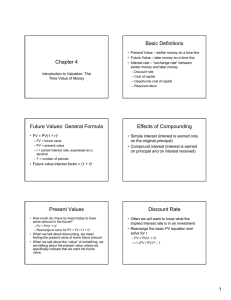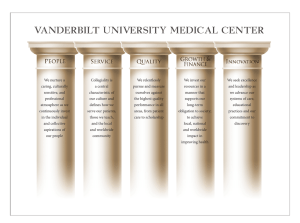Document 17881783
advertisement

MATH 1332. Section 4B and 4C. Mary Parker, January 28, 2013 page 1 4B Objectives: 1. Compute simple interest. 2. Compute compound interest, for any number of compoundings per year. 3. Distinguish between APR and APY. 4. Given an amount you want to have at the end of some number of years, find how much you’d have to invest. (For a given interest rate and times of compounding.) 5. Program at least one of these formulas into a spreadsheet to make it easy to do your homework and obtain correct answers! Simple Interest example: Invest $2000 at 5% at the beginning of the year. At the end of the year, you are paid your interest and so, at the beginning of the next year, you have $2000 invested, and you are paid 5% for that year. Compound Interest example: Invest $2000 at 5% at the beginning of the year. At the end of the year, you are owed interest on that. The agreement is that you roll the amount of interest you have earned in the account and so it is also invested. Thus, at the beginning of the next year, you have a bit more than $2000 invested. This is 5% interest compounded annually. Activity 1. Use a spreadsheet to work through two scenarios. Invest $2000 at 5% simple interest. Leave it in for ten years. Compute the amount of interest earned each year and the total amount of interest earned. Invest $2000 at 5% APR, compounded annually. Leave it in for ten years. Compute the amount of interest earned each year and the total amount of interest earned. Pages 209-213 discuss this. Activity 2: Read Example 4. Do Exercise 51 Activity 3: Read Example 5. Do Exercise 57. Discussion 4: What is the meaning of APR and APY? How are they related and how are they different? Activity 5: Read Example 6. Do Exercise 63. We omit the section on continuous compounding. You can get the same effect by compounding daily, and not have to use a new formula. Activity 6: Read Example 8 VERY carefully and see how they use the formula in a different way. This will be very important. Do Exercise 75. MATH 1332. Section 4B and 4C. Mary Parker, January 28, 2013 page 2 Formulas you’ll be given as part of the test: p. 212 top and p. 216 bottom. What is the difference between these? Can you use them? 4C Objectives: 1. Determine how much money you will eventually have if you invest a certain amount per month. 2. Determine how much per month you have to invest to accumulate a particular mount of money. 3. Distinguish between the total return on an investment and the annual return. Compute each. 4. With the help of examples and discussion with other students, read a stock quote and a mutual fund quote. Answer questions about these. 5. Describe and distinguish between the three basic types of investments (stock, bond, and cash.) Compare these in terms of liquidity, risk, and return. 6. Program at least one of these formulas into a spreadsheet to make it easy to do your homework. Activity 1: What is a savings plan? (Work with a partner. Write your answer.) Activity 2: Learn to use the formula for a savings plan. Read the Example 1 solution. Try to do Example 2 without looking at the solution. Compare your work with the solution. Then do Exercise 29. Activity 3: Read Example 4. What is different about it this question about a savings plan? How does the formula look different? Do Exercise 36. When you finish, you have found a payment. Now go back to our original Savings Plan formula and plug in that payment. Does it give you the amount that was asked for? This is a way to check without having to look at the back of the book. Activity 4: Distinguish between the total return and the annual return. Read Example 5 and do Exercise 37. Activity 5: Learn to read Stock Quotes and Mutual Fund Quotes, when following an example and discussing it with other students. Do that by discussing examples 8 and 10. Then do the homework problems 47, 49, 63 and 73 together. Formulas you’ll be given as a part of the test: p. 228 middle, p. 233 middle, p. 234 middle. HW / Quiz 3. Due at the beginning of class Wed. Feb. 6 4B. Exercises 6, 43, 49, 55, 63, 75, 79, 87, 91 4C Exercises 3-5, 23, 27, 31, 35, 39, 45, 47, 49, 63, 65, 69, 73, 77 Start a new page. Write on front only: Quiz : 4B: 9, 14, 86, 88 and 4C: 10, 13, 32




